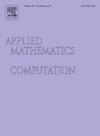四边形圆柱和环面多米诺骨牌平铺的翻转图的分量
IF 3.4
2区 数学
Q1 MATHEMATICS, APPLIED
引用次数: 0
摘要
设R是一个四边形曲面,可能有边界,由单位正方形组成,每个内部顶点被4个正方形包围。R的平铺是多米诺骨牌(一对相邻的方块)的放置,这样就没有空隙或重叠。R的翻转图是这样一个图,它的顶点都是R的平铺,如果我们能通过翻转得到两个平铺是相邻的(90°旋转一对并排的多米诺骨牌)。利用图论方法,证明了2mx (2n+1)四边形柱面的翻转图仍然是连通的,而2mx (2n+1)四边形环面的翻转图由两个同构分量组成。对于一个平铺t,我们将一个整数,称为强制数,作为t中不包含在其他平铺中的最小多米诺骨牌数。结果表明,在2mx (2n+1)个四边形柱面和环面中,所有铺层的强迫数分别形成一个最大值为(n+1)m的整数区间。本文章由计算机程序翻译,如有差异,请以英文原文为准。
Components of flip graphs of domino tilings in quadriculated cylinder and torus
Let be a quadriculated surface, possibly with boundary, consisting of unit squares, and each interior vertex being surrounded by 4 squares. A tiling of is a placement of dominoes (a pair of adjacent squares) so that there are no gaps or overlaps. The flip graph of is a graph whose vertices are all tilings of and two tilings are adjacent if we can obtain one from another by a flip ( rotation of a pair of side-by-side dominoes). By using graph-theoretical approach, we prove that the flip graph of quadriculated cylinder is still connected, but that of quadriculated torus consists of two isomorphic components. For a tiling , we associate an integer, called forcing number, as the minimum number of dominoes in that is contained in no other tilings. As a consequence, we obtain that the forcing numbers of all tilings in quadriculated cylinder and torus form respectively an integer interval whose maximum value is .
求助全文
通过发布文献求助,成功后即可免费获取论文全文。
去求助
来源期刊
CiteScore
7.90
自引率
10.00%
发文量
755
审稿时长
36 days
期刊介绍:
Applied Mathematics and Computation addresses work at the interface between applied mathematics, numerical computation, and applications of systems – oriented ideas to the physical, biological, social, and behavioral sciences, and emphasizes papers of a computational nature focusing on new algorithms, their analysis and numerical results.
In addition to presenting research papers, Applied Mathematics and Computation publishes review articles and single–topics issues.

 求助内容:
求助内容: 应助结果提醒方式:
应助结果提醒方式:


